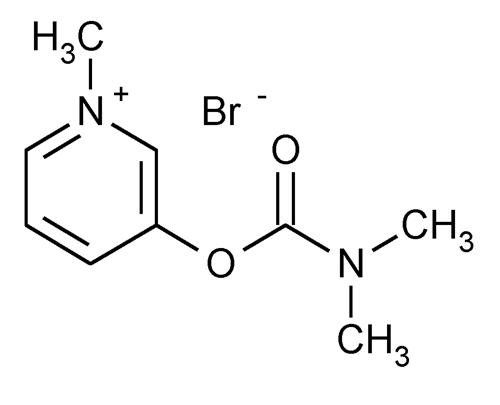Pyridostigmine Bromide
Pyridinium, 3-[[(dimethylamino)carbonyl]oxy]-1-methyl-, bromide.
3-Hydroxy-1-methylpyridinium bromide dimethylcarbamate
» Pyridostigmine Bromide contains not less than 98.5 percent and not more than 100.5 percent of C9H13BrN2O2, calculated on the dried basis.
Packaging and storage—
Preserve in tight containers.
Identification—
Solution:
35 µg per mL.
Medium:
0.1 N hydrochloric acid.
Absorptivities at 269 nm, calculated on the dried basis, do not differ by more than 3.0%.
C:
To about 100 mg in a test tube add 0.6 mL of 1 N sodium hydroxide: an orange color develops. When the mixture is heated, the color changes to yellow, and a strip of moistened red litmus paper held over the top of the test tube turns blue.
D:
A solution (1 in 50) responds to tests for Bromide  191
191 .
.
Loss on drying  731
731 —
Dry it in a suitable vacuum drying tube, using phosphorus pentoxide as the desiccant, at 100
—
Dry it in a suitable vacuum drying tube, using phosphorus pentoxide as the desiccant, at 100 for 4 hours: it loses not more than 2.0% of its weight.
for 4 hours: it loses not more than 2.0% of its weight.
Residue on ignition  281
281 :
not more than 0.1%.
:
not more than 0.1%.
Ordinary impurities  466
466 —
—
Test solution:
methanol.
Standard solution:
methanol.
Eluant:
a mixture of methanol and water (1:1); the thin-layer chromatographic plate coating material is cellulose with a fluorescent indicator.
Visualization:
1.
Assay—
Dissolve about 850 mg of Pyridostigmine Bromide, accurately weighed, in 80 mL of glacial acetic acid. Add 25 mL of mercuric acetate TS and 2 drops of quinaldine red TS, and titrate with 0.1 N perchloric acid in dioxane VS to a colorless endpoint. Perform a blank determination, and make any necessary correction. Each mL of 0.1 N perchloric acid is equivalent to 26.11 mg of C9H13BrN2O2.
Auxiliary Information—
Please check for your question in the FAQs before contacting USP.
Chromatographic Column—
| Topic/Question | Contact | Expert Committee |
| Monograph | Ravi Ravichandran, Ph.D.
Senior Scientist 1-301-816-8330 |
(MDPP05) Monograph Development-Psychiatrics and Psychoactives |
| Reference Standards | Lili Wang, Technical Services Scientist 1-301-816-8129 RSTech@usp.org |
USP32–NF27 Page 3449
Pharmacopeial Forum: Volume No. 29(6) Page 1977
Chromatographic columns text is not derived from, and not part of, USP 32 or NF 27.
